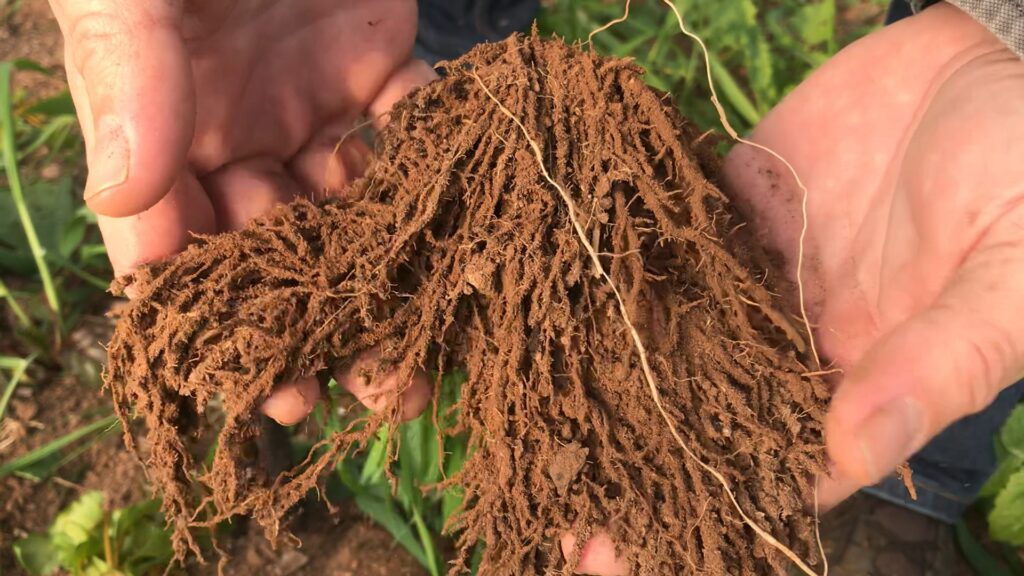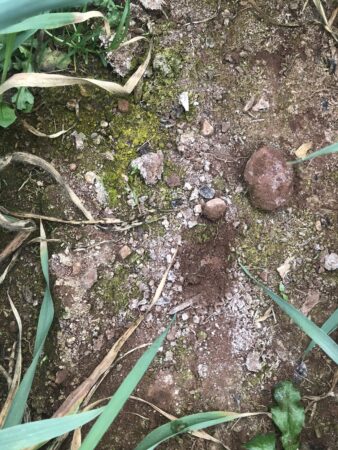
Features
Soil
Roadmap to resiliency in greenhouse soils
August 16, 2023 By Talia Plaskett, Perennia protected crop specialist
 Signs of soil aggregation can be spotted throughout the root mass of these oats, implemented as a winter cover crop in a tunnel. Photos courtesy of Perennia.
Signs of soil aggregation can be spotted throughout the root mass of these oats, implemented as a winter cover crop in a tunnel. Photos courtesy of Perennia. Careful management of fertility in protected soil-based production systems is necessary for preserving healthy, resilient soils from season to season. One of the unique challenges to soil health in protected spaces is the exclusion of precipitation.

White, crystallized salts observed across the top of a greenhouse soil bed.
Field soils benefit from the bulk movement of water through the soil during the off-season, flushing out residual salts on a regular basis. Elements such as phosphorus (P), calcium (Ca2+), magnesium (Mg 2+) and potassium (K+), collectively referred to as salts, accumulate in greenhouse soil when they are not regularly flushed. Salt accumulation directly impacts plant productivity, namely a reduction in the capacity to extract water from the soil and decreased nutrient availability.
Greenhouse soils typically see an increase in pH over time, and this disruption of nutrient availability becomes increasingly complicated when considering the dynamics surrounding cation exchange capacity. Crop access to key nutrients can be significantly impaired despite an overabundance in the soil. Take potassium, for example: large quantities of calcium and magnesium relative to abundant amounts of potassium in the soil can result in plants showing extreme signs of potassium deficiency, directly reducing the volume of marketable produce from that space.
Understanding the scope of the problem is the first step to turning things around for greenhouse soils. Implementing a combination of best management practices will prevent nutrient overload in the first place and begin to restore the balance where salt accumulation has already taken place.
First and foremost, removing tunnel plastics on a semi-regular basis provides an opportunity for the soil to recalibrate. Removal in the fall would allow for an exposed winter season, followed by re-skinning the tunnel for an early spring. The recommended three- to five-year lifespan of plastic mimics an acceptable frequency of soil flushes in protected spaces.
Simulated flooding has proven to be effective, but less so than plastic removal. For those considering regular flooding between crops, consider the method of water application. Running large volumes through small point sources, such as drip tape, will be less effective than flooding the space with a hose. It is also important to get the source water tested before flooding to ensure that the issue is not exacerbated. Even low levels of salt, when applied in large quantities, will cause problems.
The nutritional breakdown of fertilizers is key in preventing excessive nutrient buildup in the soil. For amendments that do not come with a manufacturer guarantee, it is worth submitting those amendments (ex. compost, manure) for testing before incorporating them into the soil. Where the focus is traditionally on N-P-K values, it’s worth reading through the entire analysis to see what additional nutrients are present.
In the pursuit of nitrogen, it is very easy to over-apply other nutrients that can impede crop water and nutrient uptake. Consider using single-source fertility supplements (ex. 15-0-0) to ensure that key production elements are applied appropriately. Amendments containing two to three times the amount of phosphorus to nitrogen, for example, can result in significant overapplication of phosphorus to meet the nitrogen needs of the crop. Where phosphorus is difficult to remove from the soil, this quickly becomes problematic.
When it comes to nutrient application, consider split applications as opposed to relying solely on a pre-plant application. Supplying a season’s worth of nitrogen at once increases the potential for nitrogen leaching into ground water systems compared to producers who opt for small, scheduled applications through the season. This also gives the producer an opportunity to target the nutritional needs of the crop at crucial times.
Protected spaces tend to be the hardest-worked soils on farms, and implementing cover crops is an opportunity to improve crop rotation. Cover crops increase carbon sequestration, support soil aggregation and contribute to organic matter. Depending on the species selected, cover crops can also help improve drainage, reduce disease and pest levels and fix nitrogen in the soil. A ‘dead’ mulch applied in a greenhouse will contribute to organic matter; however, the soil itself will not see the same structural benefits compared to a cover crop that is actively growing in it. Maintaining soil structure is crucial for the long-term resiliency of the production space, so implementing semi-regular cover crops is a tool to consider implementing.
Through careful nutrient application, the incorporation of cover crops, and semi-regular exposures to overhead precipitation, soil-based tunnel production can prosper for many years.
Print this page